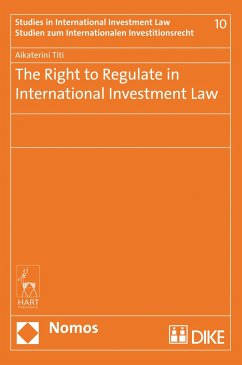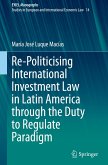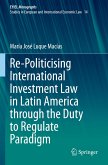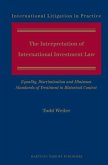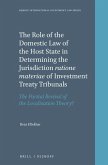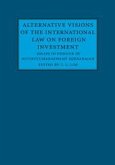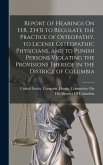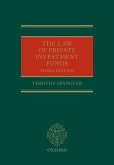Catharine Titi
The Right to Regulate in International Investment Law
Catharine Titi
The Right to Regulate in International Investment Law
- Gebundenes Buch
- Merkliste
- Auf die Merkliste
- Bewerten Bewerten
- Teilen
- Produkt teilen
- Produkterinnerung
- Produkterinnerung
Since the inception of the international investment law system, investment promotion and protection have been the raison d'être of investment treaties and states have confined their policy space in order to attract foreign investment and protect their investors abroad. Languishing in relative obscurity until recently, the right to regulate has gradually come to the spotlight as a key component of negotiations on new generation investment agreements around the globe. States and regional organisations, including, notably, the European Union and the United States, have started to examine ways in…mehr
Andere Kunden interessierten sich auch für
![Re-Politicising International Investment Law in Latin America through the Duty to Regulate Paradigm Re-Politicising International Investment Law in Latin America through the Duty to Regulate Paradigm]() María José Luque MacíasRe-Politicising International Investment Law in Latin America through the Duty to Regulate Paradigm110,99 €
María José Luque MacíasRe-Politicising International Investment Law in Latin America through the Duty to Regulate Paradigm110,99 €![Re-Politicising International Investment Law in Latin America through the Duty to Regulate Paradigm Re-Politicising International Investment Law in Latin America through the Duty to Regulate Paradigm]() María José Luque MacíasRe-Politicising International Investment Law in Latin America through the Duty to Regulate Paradigm110,99 €
María José Luque MacíasRe-Politicising International Investment Law in Latin America through the Duty to Regulate Paradigm110,99 €![The Interpretation of International Investment Law The Interpretation of International Investment Law]() Todd WeilerThe Interpretation of International Investment Law264,99 €
Todd WeilerThe Interpretation of International Investment Law264,99 €![The Role of the Domestic Law of the Host State in Determining the Jurisdiction Ratione Materiae of Investment Treaty Tribunals The Role of the Domestic Law of the Host State in Determining the Jurisdiction Ratione Materiae of Investment Treaty Tribunals]() Reza EftekharThe Role of the Domestic Law of the Host State in Determining the Jurisdiction Ratione Materiae of Investment Treaty Tribunals219,99 €
Reza EftekharThe Role of the Domestic Law of the Host State in Determining the Jurisdiction Ratione Materiae of Investment Treaty Tribunals219,99 €![Alternative Visions of the International Law on Foreign Investment Alternative Visions of the International Law on Foreign Investment]() Alternative Visions of the International Law on Foreign Investment175,99 €
Alternative Visions of the International Law on Foreign Investment175,99 €![Report of Hearings On H.R. 23431 to Regulate the Practice of Osteopathy, to License Osteopathic Physicians, and to Punish Persons Violating the Provis Report of Hearings On H.R. 23431 to Regulate the Practice of Osteopathy, to License Osteopathic Physicians, and to Punish Persons Violating the Provis]() Report of Hearings On H.R. 23431 to Regulate the Practice of Osteopathy, to License Osteopathic Physicians, and to Punish Persons Violating the Provis34,99 €
Report of Hearings On H.R. 23431 to Regulate the Practice of Osteopathy, to License Osteopathic Physicians, and to Punish Persons Violating the Provis34,99 €![The Law of Private Investment Funds The Law of Private Investment Funds]() Timothy SpanglerThe Law of Private Investment Funds442,99 €
Timothy SpanglerThe Law of Private Investment Funds442,99 €-
-
-
Since the inception of the international investment law system, investment promotion and protection have been the raison d'être of investment treaties and states have confined their policy space in order to attract foreign investment and protect their investors abroad. Languishing in relative obscurity until recently, the right to regulate has gradually come to the spotlight as a key component of negotiations on new generation investment agreements around the globe. States and regional organisations, including, notably, the European Union and the United States, have started to examine ways in which to safeguard their regulatory power and guide - and delimit - the interpretive power of arbitral tribunals, by reserving their right to pursue specific public policy objectives. The monograph explores the status quo of the right to regulate, in order to offer an appraisal and a reference tool for treatymakers, thus contributing to a better understanding of the concept and the broader discourse on how to enhance the investment law system's legitimacy.
Hinweis: Dieser Artikel kann nur an eine deutsche Lieferadresse ausgeliefert werden.
Hinweis: Dieser Artikel kann nur an eine deutsche Lieferadresse ausgeliefert werden.
Produktdetails
- Produktdetails
- Verlag: Bloomsbury Academic
- Seitenzahl: 240
- Erscheinungstermin: 9. Juni 2014
- Englisch
- Abmessung: 224mm x 155mm x 25mm
- Gewicht: 635g
- ISBN-13: 9781849466110
- ISBN-10: 1849466114
- Artikelnr.: 40758996
- Herstellerkennzeichnung
- Produktsicherheitsverantwortliche/r
- Europaallee 1
- 36244 Bad Hersfeld
- gpsr@libri.de
- Verlag: Bloomsbury Academic
- Seitenzahl: 240
- Erscheinungstermin: 9. Juni 2014
- Englisch
- Abmessung: 224mm x 155mm x 25mm
- Gewicht: 635g
- ISBN-13: 9781849466110
- ISBN-10: 1849466114
- Artikelnr.: 40758996
- Herstellerkennzeichnung
- Produktsicherheitsverantwortliche/r
- Europaallee 1
- 36244 Bad Hersfeld
- gpsr@libri.de
Catharine Titi works on issues in international investment law and international arbitration.
I. Introduction
II. The right to regulate: general observations
A. The right to regulate: what's in a name.
B. . and what's not in the name
1. Limiting the scope of investment protection
2. Deference afforded at tribunal discretion
3. Clarifications and interpretative statements
4. Doing away with investor-state dispute settlement
5. Elimination of the umbrella clause
6. Exceptions versus reservations
C. Concluding remarks
III. The right to regulate in context
A. The pre-modern-investment-world regime
B.WTO law, EU law and the European Convention on Human
Rights
C. Some developments at the bilateral level
D.Developments at the plurilateral level: the Trans-Pacific Partnership
Agreement
E.Developments at the collective level: the right to regulate and European
investment agreements
F. Concluding remarks
IV. The rationale for inserting a right to regulate
A. Arbitration as a perceived threat to state regulatory freedom
B. Policy space as a remedy to a systemic imbalance
C. Concluding remarks
V. Types of regulatory interests
A. General observations
B. Essential security interests
1. General observations on essential security interests
2.Essential security interests, economic crises and economic security
3.Essential security interests and access to strategic
industries
4. Essential interests
5. International peace and security
6. Circumstances of extreme emergency
C. Public order (ordre public)
D. Regulation in the public interest
E. Concluding remarks
VI. Positive language on regulatory interests
A. Positive language
B. 'Declaratory' right to regulate
C. The right to regulate and the preamble
D. Concluding remarks
VII. The right to regulate in IIAs
A. General observations
B. The right to regulate in the respective standards of treatment
1. General remarks
2.The right to regulate and the contingent standards of treatment:
most-favoured-nation treatment and national treatment
i. General observations
ii. The REIO exception in the contingent standards
iii.Idiosyncratic exceptions to the non-discrimination standards
iv. Non-extension of the MFN treatment to ISDS
v.The right to regulate and the 'in like circumstances'
formula
3.The right to regulate and the fair and equitable treatment,the minimum
standard of treatment and full protection and security
4. The right to regulate and expropriation
i. The right to regulate and expropriation in general
ii.Exception to the expropriation standard modelled on the ECHR - A
consideration de lege ferenda?
5. The right to regulate and the free transfer of capital
i.Exceptions relating to bankruptcy, securities'trading, criminal offences,
compliance with adjudicatory proceedings and the soundness of financial
institutions
ii.Temporary derogations in case of balance-ofpayments crises and
difficulties for monetary and exchange rate policies
iii.The REIO exception and capital transfers (EU/BIT Judgments-related
exception)
6. The right to regulate and performance requirements
7. The right to regulate and provisions on compensation for losses
C.The right to regulate as a general regulatory clause (or
general exceptions applicable to the entire treaty)
1. General remarks
2. General regulatory clauses and the public interest ('General exceptions'
modelled after Article XX GATT or the right to regulate by subject: the
public interest)
i. General exceptions clauses modelled after Article XX GATT
ii. Relevance of GATT/WTO jurisprudence
iii. Relevance of general exceptions clauses modeled after Article XX GATT
to specific standards of treatment and regulatory interests
a. Expropriation
b. National and most-favoured-nation treatment
c. Fair and equitable treatment, minimum standard of treatment and full
protection and security
d. Transfers of capital
e. Performance requirements
f. The chapeau (or equivalent) and national security exceptions
D. Concluding remarks
11
The nexus requirement, self-judging clauses and the standard of review of
exceptions
VIII.
A. The nexus requirement
B. 'The State considers' - Self-Judging clauses
1. General
2. The standard of review of self-judging clauses
C.The standard of review in the absence of a self-judging clause
D. Concluding remarks
IX. The right to regulate by subject
A. Essential security interests
B. Taxation
C. Cultural diversity
1. Introduction
2. The exception for cultural diversity
3. Considerations for cultural policy outside the stricto sensu investment
context
4. Cultural exception, exception for cultural policy and the investment law
context
i. The Multilateral Agreement on Investment and the exception for culture
ii.France and 'the framework of measures designed to preserve and promote
cultural and linguistic diversity'
iii. The European Union and the promotion of cultural diversity
iv. The Canadian approach: carving cultural industries out of the scope of
the agreement
D. Concluding remarks
X. The right to regulate beyond IIAs in general international law
A. The right to regulate under customary international law as reflected in
the ILC Articles
1. General
2. Necessity
i. Necessity and the criteria for its successful invocation
ii. Practical availability of the necessity defence
iii. Does customary international law provide a national security defence?
3. Force majeure and distress
4. Legal nature and effects of upholding a defence under the ILC Articles
i. Legal nature and operation of the defence
ii. Compensation
5. ILC defences and the right to regulate. Some further reflections
B. Ius cogens
C. The clausula rebus sic stantibus and bribery
D. Concluding remarks
XI. Arbitral jurisprudence on the right to regulate (beyond IIAs and
general international law) and the question of an implicit right to
regulate
A. General observations
B. Arbitral jurisprudence and the legitimate interests of the host state
(examination by standard)
1. The fair and equitable treatment
2. Expropriation
3. Concluding remarks
C. The protection of essential security interests in the absence of an
express treaty-based right to regulate
D. Are explicit treaty exceptions necessary to reserve policy space?
E. Is an explicit treaty-based right to regulate harmful to
regulatory freedom?
F. Concluding remarks
VI. Conclusion
II. The right to regulate: general observations
A. The right to regulate: what's in a name.
B. . and what's not in the name
1. Limiting the scope of investment protection
2. Deference afforded at tribunal discretion
3. Clarifications and interpretative statements
4. Doing away with investor-state dispute settlement
5. Elimination of the umbrella clause
6. Exceptions versus reservations
C. Concluding remarks
III. The right to regulate in context
A. The pre-modern-investment-world regime
B.WTO law, EU law and the European Convention on Human
Rights
C. Some developments at the bilateral level
D.Developments at the plurilateral level: the Trans-Pacific Partnership
Agreement
E.Developments at the collective level: the right to regulate and European
investment agreements
F. Concluding remarks
IV. The rationale for inserting a right to regulate
A. Arbitration as a perceived threat to state regulatory freedom
B. Policy space as a remedy to a systemic imbalance
C. Concluding remarks
V. Types of regulatory interests
A. General observations
B. Essential security interests
1. General observations on essential security interests
2.Essential security interests, economic crises and economic security
3.Essential security interests and access to strategic
industries
4. Essential interests
5. International peace and security
6. Circumstances of extreme emergency
C. Public order (ordre public)
D. Regulation in the public interest
E. Concluding remarks
VI. Positive language on regulatory interests
A. Positive language
B. 'Declaratory' right to regulate
C. The right to regulate and the preamble
D. Concluding remarks
VII. The right to regulate in IIAs
A. General observations
B. The right to regulate in the respective standards of treatment
1. General remarks
2.The right to regulate and the contingent standards of treatment:
most-favoured-nation treatment and national treatment
i. General observations
ii. The REIO exception in the contingent standards
iii.Idiosyncratic exceptions to the non-discrimination standards
iv. Non-extension of the MFN treatment to ISDS
v.The right to regulate and the 'in like circumstances'
formula
3.The right to regulate and the fair and equitable treatment,the minimum
standard of treatment and full protection and security
4. The right to regulate and expropriation
i. The right to regulate and expropriation in general
ii.Exception to the expropriation standard modelled on the ECHR - A
consideration de lege ferenda?
5. The right to regulate and the free transfer of capital
i.Exceptions relating to bankruptcy, securities'trading, criminal offences,
compliance with adjudicatory proceedings and the soundness of financial
institutions
ii.Temporary derogations in case of balance-ofpayments crises and
difficulties for monetary and exchange rate policies
iii.The REIO exception and capital transfers (EU/BIT Judgments-related
exception)
6. The right to regulate and performance requirements
7. The right to regulate and provisions on compensation for losses
C.The right to regulate as a general regulatory clause (or
general exceptions applicable to the entire treaty)
1. General remarks
2. General regulatory clauses and the public interest ('General exceptions'
modelled after Article XX GATT or the right to regulate by subject: the
public interest)
i. General exceptions clauses modelled after Article XX GATT
ii. Relevance of GATT/WTO jurisprudence
iii. Relevance of general exceptions clauses modeled after Article XX GATT
to specific standards of treatment and regulatory interests
a. Expropriation
b. National and most-favoured-nation treatment
c. Fair and equitable treatment, minimum standard of treatment and full
protection and security
d. Transfers of capital
e. Performance requirements
f. The chapeau (or equivalent) and national security exceptions
D. Concluding remarks
11
The nexus requirement, self-judging clauses and the standard of review of
exceptions
VIII.
A. The nexus requirement
B. 'The State considers' - Self-Judging clauses
1. General
2. The standard of review of self-judging clauses
C.The standard of review in the absence of a self-judging clause
D. Concluding remarks
IX. The right to regulate by subject
A. Essential security interests
B. Taxation
C. Cultural diversity
1. Introduction
2. The exception for cultural diversity
3. Considerations for cultural policy outside the stricto sensu investment
context
4. Cultural exception, exception for cultural policy and the investment law
context
i. The Multilateral Agreement on Investment and the exception for culture
ii.France and 'the framework of measures designed to preserve and promote
cultural and linguistic diversity'
iii. The European Union and the promotion of cultural diversity
iv. The Canadian approach: carving cultural industries out of the scope of
the agreement
D. Concluding remarks
X. The right to regulate beyond IIAs in general international law
A. The right to regulate under customary international law as reflected in
the ILC Articles
1. General
2. Necessity
i. Necessity and the criteria for its successful invocation
ii. Practical availability of the necessity defence
iii. Does customary international law provide a national security defence?
3. Force majeure and distress
4. Legal nature and effects of upholding a defence under the ILC Articles
i. Legal nature and operation of the defence
ii. Compensation
5. ILC defences and the right to regulate. Some further reflections
B. Ius cogens
C. The clausula rebus sic stantibus and bribery
D. Concluding remarks
XI. Arbitral jurisprudence on the right to regulate (beyond IIAs and
general international law) and the question of an implicit right to
regulate
A. General observations
B. Arbitral jurisprudence and the legitimate interests of the host state
(examination by standard)
1. The fair and equitable treatment
2. Expropriation
3. Concluding remarks
C. The protection of essential security interests in the absence of an
express treaty-based right to regulate
D. Are explicit treaty exceptions necessary to reserve policy space?
E. Is an explicit treaty-based right to regulate harmful to
regulatory freedom?
F. Concluding remarks
VI. Conclusion
I. Introduction
II. The right to regulate: general observations
A. The right to regulate: what's in a name.
B. . and what's not in the name
1. Limiting the scope of investment protection
2. Deference afforded at tribunal discretion
3. Clarifications and interpretative statements
4. Doing away with investor-state dispute settlement
5. Elimination of the umbrella clause
6. Exceptions versus reservations
C. Concluding remarks
III. The right to regulate in context
A. The pre-modern-investment-world regime
B.WTO law, EU law and the European Convention on Human
Rights
C. Some developments at the bilateral level
D.Developments at the plurilateral level: the Trans-Pacific Partnership
Agreement
E.Developments at the collective level: the right to regulate and European
investment agreements
F. Concluding remarks
IV. The rationale for inserting a right to regulate
A. Arbitration as a perceived threat to state regulatory freedom
B. Policy space as a remedy to a systemic imbalance
C. Concluding remarks
V. Types of regulatory interests
A. General observations
B. Essential security interests
1. General observations on essential security interests
2.Essential security interests, economic crises and economic security
3.Essential security interests and access to strategic
industries
4. Essential interests
5. International peace and security
6. Circumstances of extreme emergency
C. Public order (ordre public)
D. Regulation in the public interest
E. Concluding remarks
VI. Positive language on regulatory interests
A. Positive language
B. 'Declaratory' right to regulate
C. The right to regulate and the preamble
D. Concluding remarks
VII. The right to regulate in IIAs
A. General observations
B. The right to regulate in the respective standards of treatment
1. General remarks
2.The right to regulate and the contingent standards of treatment:
most-favoured-nation treatment and national treatment
i. General observations
ii. The REIO exception in the contingent standards
iii.Idiosyncratic exceptions to the non-discrimination standards
iv. Non-extension of the MFN treatment to ISDS
v.The right to regulate and the 'in like circumstances'
formula
3.The right to regulate and the fair and equitable treatment,the minimum
standard of treatment and full protection and security
4. The right to regulate and expropriation
i. The right to regulate and expropriation in general
ii.Exception to the expropriation standard modelled on the ECHR - A
consideration de lege ferenda?
5. The right to regulate and the free transfer of capital
i.Exceptions relating to bankruptcy, securities'trading, criminal offences,
compliance with adjudicatory proceedings and the soundness of financial
institutions
ii.Temporary derogations in case of balance-ofpayments crises and
difficulties for monetary and exchange rate policies
iii.The REIO exception and capital transfers (EU/BIT Judgments-related
exception)
6. The right to regulate and performance requirements
7. The right to regulate and provisions on compensation for losses
C.The right to regulate as a general regulatory clause (or
general exceptions applicable to the entire treaty)
1. General remarks
2. General regulatory clauses and the public interest ('General exceptions'
modelled after Article XX GATT or the right to regulate by subject: the
public interest)
i. General exceptions clauses modelled after Article XX GATT
ii. Relevance of GATT/WTO jurisprudence
iii. Relevance of general exceptions clauses modeled after Article XX GATT
to specific standards of treatment and regulatory interests
a. Expropriation
b. National and most-favoured-nation treatment
c. Fair and equitable treatment, minimum standard of treatment and full
protection and security
d. Transfers of capital
e. Performance requirements
f. The chapeau (or equivalent) and national security exceptions
D. Concluding remarks
11
The nexus requirement, self-judging clauses and the standard of review of
exceptions
VIII.
A. The nexus requirement
B. 'The State considers' - Self-Judging clauses
1. General
2. The standard of review of self-judging clauses
C.The standard of review in the absence of a self-judging clause
D. Concluding remarks
IX. The right to regulate by subject
A. Essential security interests
B. Taxation
C. Cultural diversity
1. Introduction
2. The exception for cultural diversity
3. Considerations for cultural policy outside the stricto sensu investment
context
4. Cultural exception, exception for cultural policy and the investment law
context
i. The Multilateral Agreement on Investment and the exception for culture
ii.France and 'the framework of measures designed to preserve and promote
cultural and linguistic diversity'
iii. The European Union and the promotion of cultural diversity
iv. The Canadian approach: carving cultural industries out of the scope of
the agreement
D. Concluding remarks
X. The right to regulate beyond IIAs in general international law
A. The right to regulate under customary international law as reflected in
the ILC Articles
1. General
2. Necessity
i. Necessity and the criteria for its successful invocation
ii. Practical availability of the necessity defence
iii. Does customary international law provide a national security defence?
3. Force majeure and distress
4. Legal nature and effects of upholding a defence under the ILC Articles
i. Legal nature and operation of the defence
ii. Compensation
5. ILC defences and the right to regulate. Some further reflections
B. Ius cogens
C. The clausula rebus sic stantibus and bribery
D. Concluding remarks
XI. Arbitral jurisprudence on the right to regulate (beyond IIAs and
general international law) and the question of an implicit right to
regulate
A. General observations
B. Arbitral jurisprudence and the legitimate interests of the host state
(examination by standard)
1. The fair and equitable treatment
2. Expropriation
3. Concluding remarks
C. The protection of essential security interests in the absence of an
express treaty-based right to regulate
D. Are explicit treaty exceptions necessary to reserve policy space?
E. Is an explicit treaty-based right to regulate harmful to
regulatory freedom?
F. Concluding remarks
VI. Conclusion
II. The right to regulate: general observations
A. The right to regulate: what's in a name.
B. . and what's not in the name
1. Limiting the scope of investment protection
2. Deference afforded at tribunal discretion
3. Clarifications and interpretative statements
4. Doing away with investor-state dispute settlement
5. Elimination of the umbrella clause
6. Exceptions versus reservations
C. Concluding remarks
III. The right to regulate in context
A. The pre-modern-investment-world regime
B.WTO law, EU law and the European Convention on Human
Rights
C. Some developments at the bilateral level
D.Developments at the plurilateral level: the Trans-Pacific Partnership
Agreement
E.Developments at the collective level: the right to regulate and European
investment agreements
F. Concluding remarks
IV. The rationale for inserting a right to regulate
A. Arbitration as a perceived threat to state regulatory freedom
B. Policy space as a remedy to a systemic imbalance
C. Concluding remarks
V. Types of regulatory interests
A. General observations
B. Essential security interests
1. General observations on essential security interests
2.Essential security interests, economic crises and economic security
3.Essential security interests and access to strategic
industries
4. Essential interests
5. International peace and security
6. Circumstances of extreme emergency
C. Public order (ordre public)
D. Regulation in the public interest
E. Concluding remarks
VI. Positive language on regulatory interests
A. Positive language
B. 'Declaratory' right to regulate
C. The right to regulate and the preamble
D. Concluding remarks
VII. The right to regulate in IIAs
A. General observations
B. The right to regulate in the respective standards of treatment
1. General remarks
2.The right to regulate and the contingent standards of treatment:
most-favoured-nation treatment and national treatment
i. General observations
ii. The REIO exception in the contingent standards
iii.Idiosyncratic exceptions to the non-discrimination standards
iv. Non-extension of the MFN treatment to ISDS
v.The right to regulate and the 'in like circumstances'
formula
3.The right to regulate and the fair and equitable treatment,the minimum
standard of treatment and full protection and security
4. The right to regulate and expropriation
i. The right to regulate and expropriation in general
ii.Exception to the expropriation standard modelled on the ECHR - A
consideration de lege ferenda?
5. The right to regulate and the free transfer of capital
i.Exceptions relating to bankruptcy, securities'trading, criminal offences,
compliance with adjudicatory proceedings and the soundness of financial
institutions
ii.Temporary derogations in case of balance-ofpayments crises and
difficulties for monetary and exchange rate policies
iii.The REIO exception and capital transfers (EU/BIT Judgments-related
exception)
6. The right to regulate and performance requirements
7. The right to regulate and provisions on compensation for losses
C.The right to regulate as a general regulatory clause (or
general exceptions applicable to the entire treaty)
1. General remarks
2. General regulatory clauses and the public interest ('General exceptions'
modelled after Article XX GATT or the right to regulate by subject: the
public interest)
i. General exceptions clauses modelled after Article XX GATT
ii. Relevance of GATT/WTO jurisprudence
iii. Relevance of general exceptions clauses modeled after Article XX GATT
to specific standards of treatment and regulatory interests
a. Expropriation
b. National and most-favoured-nation treatment
c. Fair and equitable treatment, minimum standard of treatment and full
protection and security
d. Transfers of capital
e. Performance requirements
f. The chapeau (or equivalent) and national security exceptions
D. Concluding remarks
11
The nexus requirement, self-judging clauses and the standard of review of
exceptions
VIII.
A. The nexus requirement
B. 'The State considers' - Self-Judging clauses
1. General
2. The standard of review of self-judging clauses
C.The standard of review in the absence of a self-judging clause
D. Concluding remarks
IX. The right to regulate by subject
A. Essential security interests
B. Taxation
C. Cultural diversity
1. Introduction
2. The exception for cultural diversity
3. Considerations for cultural policy outside the stricto sensu investment
context
4. Cultural exception, exception for cultural policy and the investment law
context
i. The Multilateral Agreement on Investment and the exception for culture
ii.France and 'the framework of measures designed to preserve and promote
cultural and linguistic diversity'
iii. The European Union and the promotion of cultural diversity
iv. The Canadian approach: carving cultural industries out of the scope of
the agreement
D. Concluding remarks
X. The right to regulate beyond IIAs in general international law
A. The right to regulate under customary international law as reflected in
the ILC Articles
1. General
2. Necessity
i. Necessity and the criteria for its successful invocation
ii. Practical availability of the necessity defence
iii. Does customary international law provide a national security defence?
3. Force majeure and distress
4. Legal nature and effects of upholding a defence under the ILC Articles
i. Legal nature and operation of the defence
ii. Compensation
5. ILC defences and the right to regulate. Some further reflections
B. Ius cogens
C. The clausula rebus sic stantibus and bribery
D. Concluding remarks
XI. Arbitral jurisprudence on the right to regulate (beyond IIAs and
general international law) and the question of an implicit right to
regulate
A. General observations
B. Arbitral jurisprudence and the legitimate interests of the host state
(examination by standard)
1. The fair and equitable treatment
2. Expropriation
3. Concluding remarks
C. The protection of essential security interests in the absence of an
express treaty-based right to regulate
D. Are explicit treaty exceptions necessary to reserve policy space?
E. Is an explicit treaty-based right to regulate harmful to
regulatory freedom?
F. Concluding remarks
VI. Conclusion

